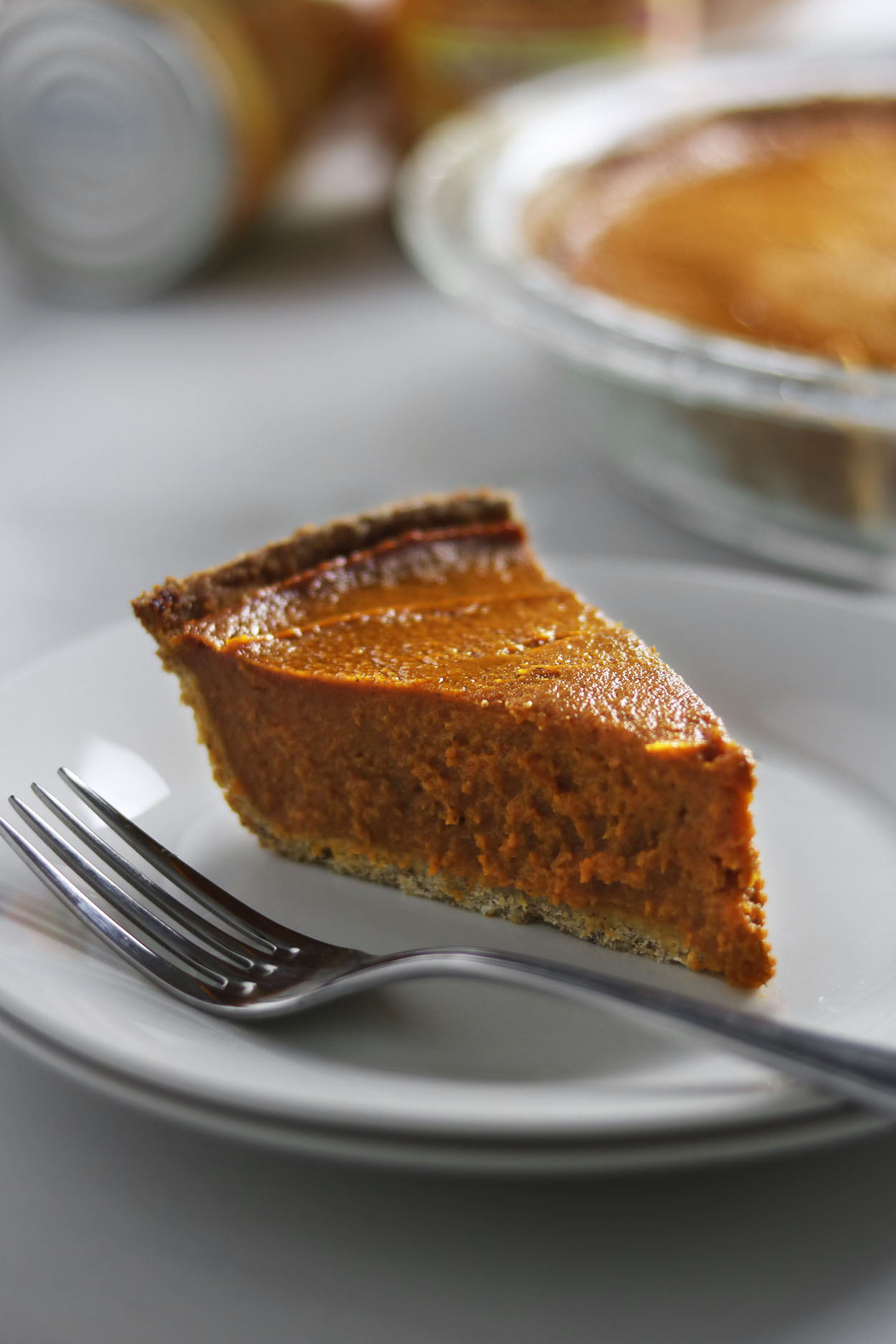If you haven’t already planned to put a pumpkin pie on the holiday menu, hopefully this one will convince you – or take the place of the one you do have planned 😉
I don’t think I can remember a single Thanksgiving where pumpkin pie wasn’t served. This one, though, is one I wanted to come up with so my Celiac family members could enjoy gluten free, oilless pumpkin pie for the holidays. And while making a dessert recipe without those things might sound lacking in flavor and intrigue, this one has truly impressed me with how good it is.
Flakey is also tough to come by in baking without saturated fat, but because the type of pie crust needed specifically for pumpkin pie is more about it’s chewy density as the base for the custard, this one impresses without the unhealthy fats.
This recipe is:
- Smooth
- Flavorful
- Flakey
- Mildly sweet
- Refreshing
It’s exactly what you’d want a pumpkin pie to be, but with just a bit less guilt!
And if you love pumpkin pie as much as I do – you’ll be able to eat and make this pie about six times in a row if you want to (like I did when testing it) and still look forward to making and eating it with your family.
If you try out this recipe, please share it with me by commenting or tagging me in a photo on Instagram @plantsnotplastic. Enjoy!

Ingredients
Equipment
Method
- Combine all crust ingredients together (except water), then start with 1/4 cup (4 tbsp) of water and start combining, adding 1 additional tbsp at a time until you get the dough to form into a ball (1)
- Cover and refrigerate while you make the filling
- For the filling, combine all ingredients in a food processor and process until well-combined, pausing to scrape down the sides if needed
- Set the filling aside and get the dough out of the fridge
- Preheat your oven to 350 degrees Fahrenheit (2)
- On a cool, floured surface, cover the top of our dough ball with a little bit of flour and use a rolling pin to slowly roll the dough out (3)
- Once you've gotten the dough large enough to fit into your pie pan, remove the crust from your surface and transfer to the pan (4)
- Cut the crust along the rim of the pan, and use any remaining dough to fill in gaps or cracks in your crust
- Add your filling, even it out, and bake your pie for 45-60 or until the center barely jiggles
- Remove from oven and let cool completely and refrigerate before serving for best consistency
- Enjoy!
Video
Notes
- I always air on the side of drier dough rather than wetter dough. The benefit of using oat flour is you don't have to be concerned about overworking it (i.e. gluten) and if your dough is too wet it will be difficult to roll out (sticking to your hands and rolling pin) and will likely stick to your surface and you won't be able to transfer it to your pie pan.
- If you're confident that your dough is the right texture, you can preheat your oven while you roll out your dough. I prefer to work on my dough in a cooler kitchen, and confirm that the texture of my dough is correct (i.e. not to flakey) before preheating my oven, so I turn my oven on once I've begun rolling out my dough and can confirm the texture is correct.
- If your dough is too flakey, it will crack early and you won't be able to roll it out. If this is the case, add another 1-2 tbsp of water and work the moisture into the dough, then cover and chill for and additional ~15 minutes before trying to roll it again. Repeat this process as needed until you get the right texture. If your dough is close to the right texture but does crack as around the edges as you're rolling it, you can use a small amount of water on the cracks to re-connect the cracks in the dough, but just make sure to cover those areas well with flour so the dough doesn't stick to your rolling pan as you're working with it.
- Rough crust only needs to be an approximate size of your pie pan - this dough doesn't tend to roll out in a perfect circle and will start to crack around the edges, but it's easy to work with and you can use leftover dough from cutting the edges of the crust to fill in any large gaps. Using a well-floured surface will be important for ensuring that your crust doesn't stick. When removing, I gently pull the crust up around the edges, working my way in to keep the crust intacted.





Leave a Reply